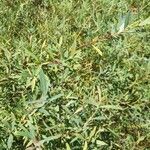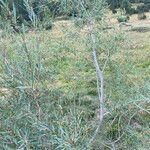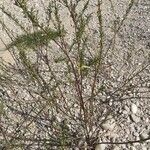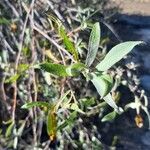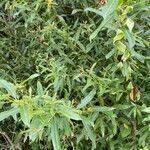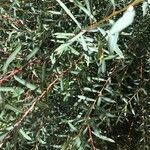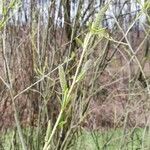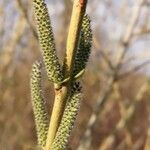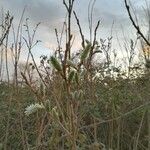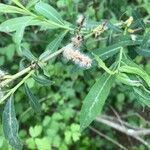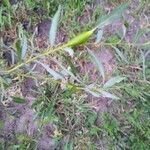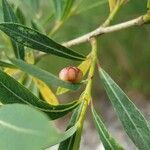Shrub or small tree to 4-(8) m high with rather smooth trunk; habit rather erect. Shoots slender, greenish or grey-green, sometimes reddish or purplish above when young, glabrous, flexible. Buds glabrous, dark. Lvs mainly alternate, opposite towards shoot apices; petiole usually < 5 mm long. Lamina 2.5-11 × 0.5-2 cm, linear, linear-lanceolate, or oblanceolate, glaucous or glaucescent, especially below, glabrous or sometimes hairy when very young, bitter to taste, finely serrulate or subentire; apex acute. Stipules 0. Catkins usually ♀, rarely ♂, appearing before lvs, erect, narrow-cylindric; rachis villous. ? catkins 1.5-3 cm long. Bracts 0.6-2 mm long, oblong to obovate, black in upper 1/2-3/4, with silky hairs; apex obtuse to rounded. Gland 1, 0.3-0.6 mm long, oblong or ovate-oblong. Stamens 2, but completely fused and appearing as 1; filaments hairy; anthers purplish. ♀ catkins 2-4 cm long, otherwise similar to ♂. Ovary white-sericeous, sessile.
Many-stemmed shrub 1–2.5 m; twigs slender, greenish-yellow or rarely purplish, glabrous; stipules none; lvs short-petioled, mostly linear-oblanceolate or spatulate or linear, 4–7(–10) cm × 7–14(18) mm, entire below, irregularly serrate toward the tip, finely raised-reticulate on both sides, with a purplish cast, glaucescent beneath, glabrous, at least some of those towards the ends of the twigs subopposite; catkins precocious, 2–3.5 cm × 5–8 mm, sessile, bracteate, subopposite; scales broadly obovate, blackish, becoming glabrate; stamens 2 but the filaments and often the anthers united; frs ovoid-conic, 3–4 mm, obtuse, sessile, short-hairy; style 0.1–0.2 mm; 2n=38. Native of Europe, sparingly escaped from cult. in our range.
A shrubby tree. It grows to 5 m high. It spreads 5 m wide. The shoots arch over and are purple. The leaves are narrow and oblong. They are bluish green above and paler underneath. The flower catkins are red but become purple-black.
